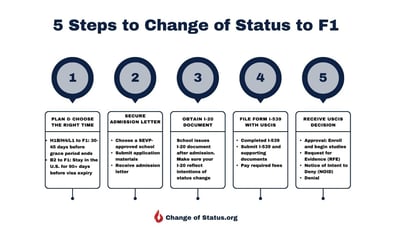Share this
Indian H4 Visa Holder Forced to Leave US After 16 Years - How Changing of Status from H4 to F1 Can Help
by Abby on Jul 1, 2024 10:22:37 AM
Roshan Taroll, an Indian-born man who spent over 16 years in the United States, recently faced the harsh reality of self-deportation after turning 21. Despite growing up with legal H4 status, Roshan aged out of his mother’s green card petition, a predicament that forced him to leave the home he had grown up in. This situation is not unique to Roshan.
This blog will explore these and other downsides of the H4 visa status, shedding light on the often-overlooked struggles faced by dependents in the U.S. immigration system. Furthermore, we will discuss how changing status from H4 to F1 can serve as a potential solution, offering increased independence, work opportunities through Day 1 CPT, and a pathway to continue living and studying in the United States beyond the limitation of the H4 visa.
Indian-born Man Forced to Self-Deport after 16 Years in US
Roshan Taroll, an Indian-born man, came to the United States on an H4 visa with his mother on H1B working visa when he was ten years old. He grew up in Boston and had to leave the US at 21 because he aged out of his H4 visa status. By changing from an H4 visa to an F1 visa, he was able to stay in the US after H4 visa, work using OPT under the F1 visa, and wait for his H1B visa application to be processed.
This is not a unique situation to Roshan. The journey of Dolica Gopisetty is another example of the struggles faced by many H4 visa holders in the US. Having moved to South Carolina in 2005, Dolica has called the USA her home for over a decade. However after living in the country for 15 years, Dolica turned 21 and aged out on H4 visa. Just like Roshan, Dolica didn't want to leave the US and changed status from H4 to F1.
In August 2018, Dolica flew to India to obtain her F1 visa. Upon her return to the US, she was treated as a foreign international student by George Mason University in Fairfax, Virginia. This change in status came with a significant financial burden, as her tuition fees as an international students were very expensive.
"My mother has struggled a lot to afford my education all these years, as my father’s H4 dependent status does not allow him to work legally. With an F1 visa, I managed to get a part-time job, but it was not without difficulty. All I can afford with my part-time income is my accommodation. I have heard that the US is a land of opportunities. But I am still waiting for opportunities to come my way," said Dolica Gopisetty with a heavy heart.
The H4 visa, while allowing dependents to accompany H1B visa holders to the United States, comes with significant limitations that extend beyond age restrictions. Most notably, H4 visa holders are generally prohibited from working, severely limiting their ability to pursue careers or contribute financially to their households.
Drawbacks of the H4 Visa
The H4 visa is for family members (spouse and children under 21) of H1B visa holders. It allows them to live in the United States while the H1B holder works. Some H4 visa holders can apply for work authorization, enabling them to seek employment. However, the visa can also have significant drawbacks.
Age Limitation
H4 dependent children lose their status when they turn 21. In the past, this wasn't often a major problem because their H1B parents were usually able to get a green card before the child reached 21, making the child eligible for a green card too. However, with the green card backlog growing for India and China, more children risk losing their status before their parents get their green cards.
The Child Status Protection Act (CSPA) helps some children by calculating their age based on the time their parent's I-140 petition was pending. If this makes them under 21 when the parent can file the I-485 application, their age is locked, allowing them to get a green card with their family. But with long waiting times, many children still age out before their parents are eligible to file, missing out on green cards.
Employment Restrictions for H4 Visa
H4 visa holders generally can't work. Spouses can only get an Employment Authorization Document (EAD) if the main H1B visa holder has an approved I-140 form in a pending green card application.
This means many H4 visa holders remain unable to work until their spouse file form I-140. This restriction can make it hard for families relying on a single income to manage their finances and maintain a stable lifestyle, leading to hardship and stress.
Limited Independence for H4 Visa Holders
As an H4 visa holder, your immigration status is tied directly to your spouse's H1B visa. If your spouse loses their job, your status is at risk too. This dependency can be frustrating, as your ability to stay in the country and maintain a stable life can feel out of your control.
What If You Divorce Your H1B Spouse?
Because your H4 status depends on being married to an H1B holder, you lose this status if you get divorced. There is no grace period, and you may start accumulating unlawful presence once the divorce is final. To prevent this, you must either leave the United States or apply for a change of status before the divorce is final.
Solution?Change Your Status From H4 to F1
Applying for a change of status from H4 to F1 offers numerous benefits, including educational opportunities, eligibility for certain types of employment, and increased financial freedom.
Educational Opportunities on an F1 Visa
Changing your status to an F1 visa allows you to access a wide range of educational opportunities..
Day 1 CPT universities are unique because they allow you to work in your field of study from your first day of classes. This means you can gain real-world experience while you learn. Combining work and study helps you apply classroom knowledge to actual job situations, making your education more practical.
Work Opportunities on an F1 Visa
A change of status from H4 to F1 allows you several pathways to employment, namely Curricular Practical Training (CPT) and Optional Practical Training (OPT). OPT allows you to work in a job related to your major, either before or after you graduate. You can work for up to 12 months and may extend this period if you're a STEM major. You need an I-20 form and must apply to USCIS for an EAD in order to work.
CPT allows you work during the semester. You can work part-time or full-time, but full-time work for 12 months on CPT will make you ineligible for OPT.
In most cases, to qualify for CPT, you must have studied for at least one year as an F1 student and be enrolled at a SEVP-certified institution. An exception exists for graduate students whose programs require immediate participation in CPT, which also known as " Day 1 CPT".
Day 1 CPT universities lets international students work off-campus in jobs or internships related to their studies right from the start of their school, no need to wait for a full academic year enrolled in the program.
Day 1 CPT has several benefits:
- It lets you begin internships or jobs right away, you can not only work on campus as a Teaching Assistance (TA) or Research Assistance (RA), but also work off-campus full time or part time and gain financial income.
- Helps you gain an independent status, no reliance on your spouse.
- It can lead to employer sponsorship for an H1B visa or green card of your own, establishing a long-term career and life in the United States.
- It helps you build your network with professions in the industry.

Process of Changing of Status from H4 to F1

Applying for a change of status from an H4 to F1 status involves several steps. These include getting admitted to a SEVP-certified university, submitting necessary documents, and handling potential Requests for Evidence (RFEs).
- Get Admitted by a SEVP-Certified University: Begin your journey by securing an acceptance letter from a college or university. Select schools known for their support for international students and detailed guidance through the visa transition process, such as Day 1 CPT, which offer multiple start dates annually, competitive tuition fees, and immediate access to the CPT program.
- Apply for Change of Status from H4 to F1:
- Complete Form I-539 online and submit supporting documents, including:
- Acceptance letter & I-20
- SEVIS fee receipt
- Recent I-94 copy
- Passport copies (including visa stamps)
- Previous I-797s (if H4 was extended in the US)
- Proof of financial capability
- Letter stating reason for change of status
- Marriage certificate
- Spouse's documents: Passport copies, recent I-94, last three pay stubs, and a cover letter if they're covering education fees
- Respond to RFE, if necessary: Sometimes, applicants might receive an RFE from the USCIS. While the success rate for addressing RFEs is high, this step can extend the timeline by three to six months and incur additional legal fees. To avoid an RFE, ensure your application is complete and includes all necessary documentation from the start.
Success Story: Changing H4 to F1 Amidst Spouse Expiring H1B
In September 2023, our client GZ faced a critical situation when her husband's H1B extension was denied, despite his I-140 petition being approved. He planned to move to Canada for work, while GZ needed to change her status from H4 to F1, and her child from H4 to F2.
GZ and her child required school admissions and visa status changes urgently. With their current visas nearing expiration, any errors could jeopardize their legal status.
Our team at GoElite, Inc. swiftly secured admission letters and necessary I-20 forms within a week. GZ submitted initial change of status application on September 27 without our help, but the application was returned on October 10 due to an incorrect Form I-539.
Our visa experts quickly reviewed and resubmitted the documents, along with an appeal letter, on October 11. Thanks to our prompt and thorough approach, their status change from H4 to F1 and F2 was approved on October 20, allowing GZ and her child to remain in the United States.
Read more about the customer story here.
Conclusion
Roshan Taroll's story is a stark reminder of the challenges faced by H4 visa holders. If you're in a similar situation, take action now to avoid uncertainty. Changing your status from H4 to F1 can open doors to new educational and career opportunities.
Secure your future by starting your H4 to F1 change of status today. Reach out to our experienced visa consultants to make your transition smooth and successful. Don't let the constraints of an H4 visa limit your potential—transform your prospects with our expert assistance.

